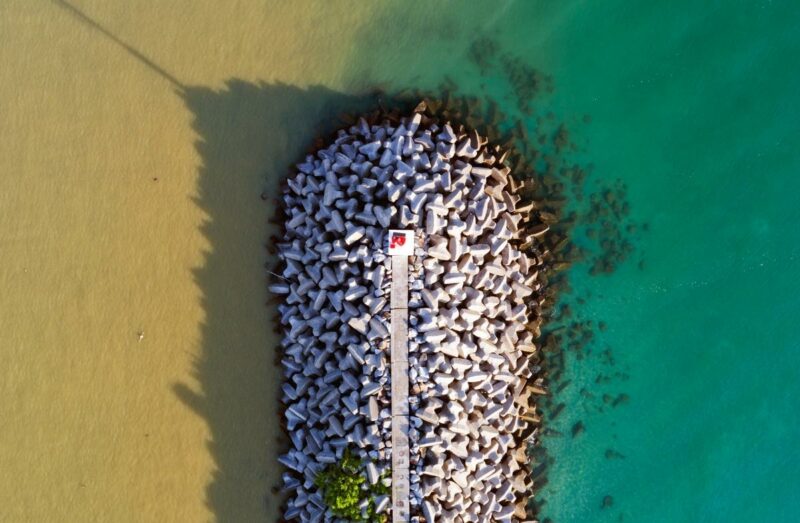Table of Contents Show
Oil meets vinegar; fresh water meets salt water. Do they mix? When oil and vinegar combine, they blend well enough to make a pretty good salad dressing. So when fresh water and salt water converge, do they mix?
You may wonder if the Pacific and Atlantic Oceans mix when they meet. According to some, they do not. Let’s debunk the myth about where two oceans meet but do not mix.
What Is It Called When Fresh Water Meets Salt Water?
To debunk this myth, we must learn a few things about how fresh water meets salt water. When this occurs, you will discover a liquid many call brackish water.
You can find brackish water in estuaries, where fresh water from a river meets salt water from the ocean. The mix of salt and fresh water in estuaries helps make them valuable natural habitats.
What Happens When Fresh Water Meets Salt Water?
When fresh water meets salt water, they form a salinity gradient. This occurs when fresh water from rivers or rain flows into the ocean, and the two liquids blend.
The mixture of fresh and salt water creates a density difference between the two layers. The fresh water is less dense than the salt water, so it flows on top of the salt water.
The denser liquid ultimately pushes against the fresh water, causing the two to mix eventually.
Does Fresh Water Sit on Top of Salt Water?
Depending on the density levels of the fresh water versus the salt water, the fresh water will sit on top of the salt water because the salt water is denser. However, the two will eventually mix. It all depends on the water, the location, the currents, the tide, and time.

For example, salinity is most significant where the fresh water meets the salt water, so you may see the fresh water sitting on top. However, as the water moves upstream, the salinity and density decrease, causing the water to mix.
Which Is Heavier: Sea Water or Fresh Water?
The term heavier to define sea water over fresh water may not be the best terminology. However if we are to use that term, seawater is heavier than fresh water.
That means that seawater is denser, and the atoms that make the sea water are more tightly-packed than those that make the fresh water. This is why when most fresh water meets seawater, the fresh water rests on top until it eventually combines.
Keep in Mind: How Does an RV Freshwater System Work? Let’s find out!
Why Is It Called Brackish Water?
When fresh water meets salt water, we call it brackish water. But why do we call it brackish?
The word “brackish” comes from the Dutch word brak, meaning salty or briny. That’s what brackish water is: a mix of fresh and salt water that is neither entirely fresh nor entirely salt.

The salt concentration in brackish water can vary greatly depending on where you find it. In some parts of the world, saline water is only slightly salty, while others can have high salt levels.
However, all brackish waters have one thing in common: they are not as fresh as pure fresh water and not as salty as pure salt water.
Are Rivers Brackish Water?
In technical terms, you could say that rivers are brackish water. Due to rainfall over billions of years consistently breaking up rocks and minerals and sending them from the rivers into the oceans, the ocean has collected a great deal of salt from these deposits.
Since the rivers transport the salt, there are small amounts of salt in fresh water. Today, the oceans collect salt from all rivers that flow into it, while fresh rainwater replenishes the rivers, drastically diminishing the salt levels.
Keep in Mind: Do you know how long you can keep fresh water in your RV tank? If not, this article is for you!
Where Can You See Fresh Water Meet Salt Water?
So what’s this myth about fresh and salt water, and why are we debunking a place where two oceans meet?
A few years ago, an image went viral on social media. It depicted two colors of water that didn’t seem to be combining.
Some said it had to be where the Atlantic meets the Pacific Ocean. While there are two very different colors of water not mixing in this image, the photo was not depicting the Pacific and the Atlantic Oceans.

The photo was of the Gulf of Alaska, where the ocean meets melting glacial freshwaters. In time, these two different-density liquids mix thanks to the varying currents.
In the meantime, if you see this happening, the different colors of the waters are quite a mysterious effect, appearing as if they don’t touch.
Whether you pay a visit to the Gulf of Alaska or happen to catch the place where a river’s fresh water meets the salt water of the sea, appreciate the curious scientific event you’re witnessing. This natural phenomenon is captivating no matter where you are.
Have you ever heard of this common myth?






